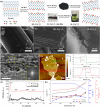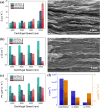Thermoelectric Modulation of Neat Ti3C2Tx MXenes by Finely Regulating the Stacking of Nanosheets
- PMID: 39724483
- PMCID: PMC11671675
- DOI: 10.1007/s40820-024-01594-z
Thermoelectric Modulation of Neat Ti3C2Tx MXenes by Finely Regulating the Stacking of Nanosheets
Abstract
Emerging two-dimensional MXenes have been extensively studied in a wide range of fields thanks to their superior electrical and hydrophilic attributes as well as excellent chemical stability and mechanical flexibility. Among them, the ultrahigh electrical conductivity (σ) and tunable band structures of benchmark Ti3C2Tx MXene demonstrate its good potential as thermoelectric (TE) materials. However, both the large variation of σ reported in the literature and the intrinsically low Seebeck coefficient (S) hinder the practical applications. Herein, this study has for the first time systematically investigated the TE properties of neat Ti3C2Tx films, which are finely modulated by exploiting different dispersing solvents, controlling nanosheet sizes and constructing composites. First, deionized water is found to be superior for obtaining closely packed MXene sheets relative to other polar solvents. Second, a simultaneous increase in both S and σ is realized via elevating centrifugal speed on MXene aqueous suspensions to obtain small-sized nanosheets, thus yielding an ultrahigh power factor up to ~ 156 μW m-1 K-2. Third, S is significantly enhanced yet accompanied by a reduction in σ when constructing MXene-based nanocomposites, the latter of which is originated from the damage to the intimate stackings of MXene nanosheets. Together, a correlation between the TE properties of neat Ti3C2Tx films and the stacking of nanosheets is elucidated, which would stimulate further exploration of MXene TEs.
Keywords: Electrical conductivity; MXene; Nanosheet stacking; Seebeck coefficient; Thermoelectrics.
© 2024. The Author(s).
Conflict of interest statement
Declarations. Conflict of Interest: The authors declare no interest conflict. They have no known competing financial interests or personal relationships that could have appeared to influence the work reported in this paper.
Figures




Similar articles
-
The Black Book of Psychotropic Dosing and Monitoring.Psychopharmacol Bull. 2024 Jul 8;54(3):8-59. Psychopharmacol Bull. 2024. PMID: 38993656 Free PMC article. Review.
-
Covalent Surface Modification of Hydrophobic Alkoxides on Ti3C2Tx MXene Nanosheets Toward Amphiphilic and Electrically Conductive Inks.Adv Mater. 2025 Jun 23:e2502440. doi: 10.1002/adma.202502440. Online ahead of print. Adv Mater. 2025. PMID: 40546008
-
[Volume and health outcomes: evidence from systematic reviews and from evaluation of Italian hospital data].Epidemiol Prev. 2013 Mar-Jun;37(2-3 Suppl 2):1-100. Epidemiol Prev. 2013. PMID: 23851286 Italian.
-
Advancements in MXene-based composites for electronic skins.J Mater Chem B. 2024 Jan 24;12(4):895-915. doi: 10.1039/d3tb02247a. J Mater Chem B. 2024. PMID: 38194290 Review.
-
Management of urinary stones by experts in stone disease (ESD 2025).Arch Ital Urol Androl. 2025 Jun 30;97(2):14085. doi: 10.4081/aiua.2025.14085. Epub 2025 Jun 30. Arch Ital Urol Androl. 2025. PMID: 40583613 Review.
Cited by
-
Designing a Sulfur Vacancy Redox Disruptor for Photothermoelectric and Cascade-Catalytic-Driven Cuproptosis-Ferroptosis-Apoptosis Therapy.Nanomicro Lett. 2025 Jul 4;17(1):321. doi: 10.1007/s40820-025-01828-8. Nanomicro Lett. 2025. PMID: 40613923 Free PMC article.
References
-
- M. Naguib, M. Kurtoglu, V. Presser, J. Lu, J. Niu et al., Two-dimensional nanocrystals produced by exfoliation of Ti3AlC2. MXenes (Jenny Stanford Publishing, 2023), pp.15–29. 10.1201/9781003306511-4
-
- Y. Gogotsi, B. Anasori, The rise of MXenes. ACS Nano 13, 8491–8494 (2019). 10.1021/acsnano.9b06394 - PubMed
-
- M. Ghidiu, M.R. Lukatskaya, M.-Q. Zhao, Y. Gogotsi, M.W. Barsoum, Conductive two-dimensional titanium carbide ‘clay’ with high volumetric capacitance. Nature 516, 78–81 (2014). 10.1038/nature13970 - PubMed
-
- M. Downes, C.E. Shuck, B. McBride, J. Busa, Y. Gogotsi, Comprehensive synthesis of Ti3C2Tx from MAX phase to MXene. Nat. Protoc. 19, 1807–1834 (2024). 10.1038/s41596-024-00969-1 - PubMed
-
- Y. Sun, D. Chen, Z. Liang, Two-dimensional MXenes for energy storage and conversion applications. Mater. Today Energy 5, 22–36 (2017). 10.1016/j.mtener.2017.04.008
LinkOut - more resources
Full Text Sources
